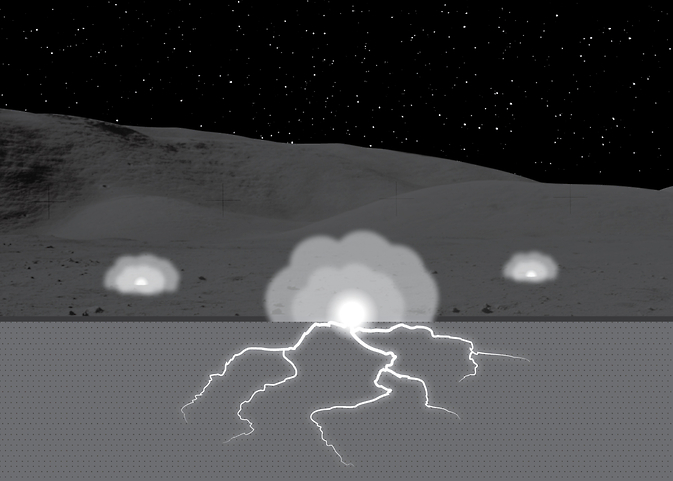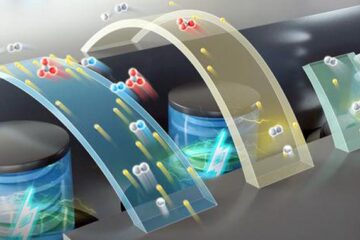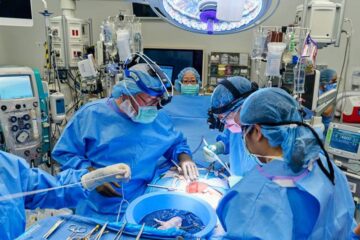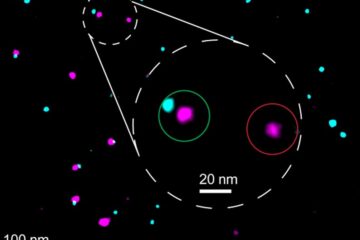Electric Sparks May Alter Evolution of Lunar Soil

This illustration shows a permanently shadowed region of the moon undergoing subsurface sparking (the "lightning bolts"), which ejects vaporized material (the "clouds") from the surface. Subsurface sparking occurs at a depth of about one millimeter. Image not to scale. Image Credit: Andrew Jordan/UNH
The study, published August 8 in the Journal of Geophysical Research-Planets, proposes that high-energy particles from uncommon, large solar storms penetrate the moon's frigid, polar regions and electrically charge the soil.
The charging may create sparking, or electrostatic breakdown, and this “breakdown weathering” process has possibly changed the very nature of the moon's polar soil, suggesting that permanently shadowed regions, which hold clues to our solar system's past, may be more active than previously thought.
“Decoding the history recorded within these cold, dark craters requires understanding what processes affect their soil,” said Andrew Jordan of the UNH Institute for the Study of Earth, Oceans, and Space and lead author of the paper.
“To that end, we built a computer model to estimate how high-energy particles detected by the Cosmic Ray Telescope for the Effects of Radiation (CRaTER) instrument on board NASA's Lunar Reconnaissance Orbiter (LRO) can create significant electric fields in the top layer of lunar soil.”
The scientists also used data from the Electron, Proton, and Alpha Monitor (EPAM) on the Advanced Composition Explorer. CRaTER, which is led by scientists from UNH, and EPAM both detect high-energy particles, including solar energetic particles (SEPs). SEPs, after being created by solar storms, stream through space and bombard the moon.
These particles can buildup electric charges faster than the soil can dissipate them and may cause sparking, particularly in the polar cold of permanently shadowed regions—unique lunar sites as cold as minus 240 degrees Celsius (minus 400 degrees Fahrenheit) that may contain water ice.
“Sparking is a process in which electrons, released from the soil grains by strong electric fields, race through the material so quickly that they vaporize little channels,” said Jordan. Repeated sparking with each large solar storm could gradually grow these channels large enough to fragment the grains, disintegrating the soil into smaller particles of distinct minerals, Jordan and colleagues hypothesize.
The next phase of this research will involve investigating whether other instruments aboard LRO could detect evidence for sparking in lunar soil, as well as improving the model to better understand the process and its consequences.
“If breakdown weathering occurs on the moon, then it has important implications for our understanding of the evolution of planetary surfaces in the solar system, especially in extremely cold regions that are exposed to harsh radiation from space,” said coauthor Timothy Stubbs of NASA's Goddard Space Flight Center in Greenbelt, Maryland.
Coauthors from the UNH CRaTER team include Jody Wilson, Nathan Schwadron, Harlan Spence and Colin Joyce.
The University of New Hampshire, founded in 1866, is a world-class public research university with the feel of a New England liberal arts college. A land, sea and space-grant university, UNH is the state's flagship public institution, enrolling 12,300 undergraduate and 2,200 graduate students.
NASA's Goddard Space Flight Center developed and manages the LRO mission. LRO's current science mission is implemented for NASA’s Science Mission Directorate. NASA's Exploration Systems Mission Directorate sponsored LRO's initial one-year exploration mission that concluded in September 2010. The research was supported in part by NASA's Solar System Exploration Research Virtual Institute (SSERVI) at NASA's Ames Research Center in Moffett Field, California. It was also funded by the DREAM2 SSERVI science team (Dynamic Response of the Environments at Asteroids, the Moon, and the moons of Mars).
For more information about LRO, visit: http://www.nasa.gov/lro
For more information about SSERVI, visit: http://sservi.nasa.gov
Story writer and UNH contact: David Sims
Institute for the Study of Earth, Oceans, and Space, University of New Hampshire
(603) 862-5369
NASA contact: Bill Steigerwald
Goddard Space Flight Center, Greenbelt, Md.
301-286-5017
Media Contact
All latest news from the category: Physics and Astronomy
This area deals with the fundamental laws and building blocks of nature and how they interact, the properties and the behavior of matter, and research into space and time and their structures.
innovations-report provides in-depth reports and articles on subjects such as astrophysics, laser technologies, nuclear, quantum, particle and solid-state physics, nanotechnologies, planetary research and findings (Mars, Venus) and developments related to the Hubble Telescope.
Newest articles

High-energy-density aqueous battery based on halogen multi-electron transfer
Traditional non-aqueous lithium-ion batteries have a high energy density, but their safety is compromised due to the flammable organic electrolytes they utilize. Aqueous batteries use water as the solvent for…

First-ever combined heart pump and pig kidney transplant
…gives new hope to patient with terminal illness. Surgeons at NYU Langone Health performed the first-ever combined mechanical heart pump and gene-edited pig kidney transplant surgery in a 54-year-old woman…

Biophysics: Testing how well biomarkers work
LMU researchers have developed a method to determine how reliably target proteins can be labeled using super-resolution fluorescence microscopy. Modern microscopy techniques make it possible to examine the inner workings…





















